Assessment of PCBs in Surface Waters at Ultratrace Levels: Traditional Approaches and Biomonitoring (Lake Baikal, Russia)
Abstract
1. Introduction
2. Materials and Methods
2.1. Sampling
2.2. Sample Processing
2.3. Instrumental Analysis
2.4. Toxicity Assessment
2.5. Statistical Methods
3. Results and Discussion
3.1. PCBs in the Upper Water Layer of the Pelagic Zone and Deep Layers of the Water Column of Lake Baikal
3.2. PCBs in Coregonus migratorius
3.3. Assessment of the PCB Concentration in the Water of Lake Baikal
3.3.1. Statistical Analysis of the Results of ‘Conventional’ Monitoring
3.3.2. Statistical Analysis of Biomonitoring Results
3.3.3. Analysis of Correlations
3.3.4. Toxicity Equivalence for Dioxin-like PCBs
3.3.5. Comparative Analysis of the PCB Concentrations in the Surface Water of the Background Sites and in Bioindicator Fish
3.4. Opportunities for Monitoring
4. Conclusions
Supplementary Materials
Author Contributions
Funding
Institutional Review Board Statement
Informed Consent Statement
Data Availability Statement
Acknowledgments
Conflicts of Interest
References
- World Economic Forum. Global Risks, 10th ed.; World Economic Forum: Geneva, Switzerland, 2015; Available online: https://www.weforum.org/reports/global-competitiveness-report-2015 (accessed on 24 September 2021).
- Kirschke, S.; Avellán, I.; Bärlund, T.; Bogardi, J.J.; Carvalho, L.; Chapman, D.; Dickens, C.W.S.; Irvine, K.; Lee, S.B.; Mehner, T.; et al. Capacity challenges in water quality monitoring: Understanding the role of human developmet. Environ. Monit. Assess. 2020, 192, 298. [Google Scholar] [CrossRef] [PubMed]
- Wong, F.; Hung, H.; Dryfhout-Clark, H.; Aas, W.; Bohlin-Nizzetto, P.; Breivik, K.; Mastromonaco, M.N.; Lundén, E.B.; Ólafsdóttir, K.; Sigurðsson, Á.; et al. Time trends of persistent organic pollutants (POPs) and Chemicals of Emerging Arctic Concern (CEAC) in Arctic air from 25 years of monitoring. Sci. Total Environ. 2021, 775, 145109. [Google Scholar] [CrossRef] [PubMed]
- Wolska, L.; Mechlinska, A.; Rogowska, J.; Namiesnik, J. Sources and fate of PAHs and PCBs in the marine environment. Crit. Rev. Environ. Sci. Technol. 2012, 42, 1172–1189. [Google Scholar] [CrossRef]
- Cipro, C.V.Z.; Colabuono, F.I.; Taniguchi, S.; Montone, R.C. Persistent organic pollutants in bird, fish and invertebrate samples from King George Island. Antarct. Antarct. Sci. 2013, 25, 545–552. [Google Scholar] [CrossRef]
- Gakuba, E.; Moodley, B.; Ndungu, P.; Birungi, G. Occurrence and significance of polychlorinated biphenyls in water, sediment pore water and surface sediments of Umgeni River, KwaZulu-Natal, South Africa. Environ. Monit. Assess. 2015, 187, 568. [Google Scholar] [CrossRef]
- Stockholm Convention. About Persistent Organic Pollutants (CO3). As Amended in 2017. Available online: http://Downloads/UNEP-POPS-COP-CONVTEXT-2017 (accessed on 21 December 2021).
- OSPAR Commission. Protecting and Conserving the North-East Atlantic and Its Resources. Available online: http://www.ospar.org/convention (accessed on 21 December 2021).
- Carrizo, D.; Gustafsson, Ö. Distribution and Inventories of Polychlorinated Biphenyls in the Polar Mixed Layer of Seven Pan-Arctic Shelf Seas and the Interior Basins. Sci. Technol. 2011, 45, 1420–1427. [Google Scholar] [CrossRef] [PubMed]
- Lohmann, R.; Dachs, J. World Seas: An Environmental Evaluation, 2nd ed.; Volume III: Ecological Issues and Environmental Impacts; Academic Press: Cambridge, MA, USA, 2019; pp. 269–282. [Google Scholar] [CrossRef]
- Samsonov, D.P.; Kochetkov, A.I.; Pasynkova, E.M.; Zapevalov, M.A. Levels of Persistent Organic Pollutants in the Components of the Lake Baikal Unique Ecosystem. Russ. Meteorol. Hydrol. 2017, 42, 345–352. [Google Scholar] [CrossRef]
- Lohmann, R.; Markham, E.; Khalova, I.; Sunderland, E.M.; Kukucka, P.; Pribylova, P.; Gong, X.; Pockalny, R.; Yanishevsky, T.; Wagner, C. Trends of Diverse POPs in Air and Water Across the Western Atlantic Ocean: Strong Gradients in the Ocean but Not in the Air. Environ. Sci. Technol. 2021, 55, 9498–9507. [Google Scholar] [CrossRef]
- Lohmann, R.; Muir, D. Global Aquatic Passive Sampling (AQUA-GAPS): Using passive samplers to monitor POPs in the waters of the world. Environ. Sci. Technol. 2010, 44, 860–864. [Google Scholar] [CrossRef]
- Reddy, A.V.B.; Moniruzzaman, M.; Aminabhavi, T.M. Polychlorinated biphenyls (PCBs) in the environment: Recent updates on sampling, pretreatment, cleanup technologies and their analysis. Chem. Eng. J. 2019, 358, 1186–1207. [Google Scholar] [CrossRef]
- Muir, D.; Sverko, E. Analytical methods for PCBs and organochlorine pesticides in environmental monitoring and surveillance: A critical appraisal. Anal. Bioanal. Chem. 2006, 386, 769–789. [Google Scholar] [CrossRef] [PubMed]
- Tanabe, S.; Subramanian, A. Bioindicators of POPs; University Press and Trans Pacific Press: Kyoto, Japan, 2006; 172p. [Google Scholar]
- Manirakiza, P.; Covaci, A.; Nizigiymana, L.; Ntakimazi, G.; Schepens, P. Persistent chlorinated pesticides and polychlorinated biphenyls in selected fish species from Lake Tanganyika, Burundi, Africa. Environ. Pollut. 2002, 117, 447–455. [Google Scholar] [CrossRef]
- Szlinder-Richert, J.; Barska, I.; Mazerski, J.; Usydus, Z. PCBs in fish from the southern Baltic Sea: Levels, bioaccumulation features, and temporal trends during the period from 1997 to 2006. Mar. Pollut. Bull. 2009, 58, 85–92. [Google Scholar] [CrossRef]
- Szlinder-Richert, J.; Barska, I.; Usydus, Z.; Ruczynska, W.; Grabic, R. Investigation of PCDD/Fs and dl-PCBs in fish from the southern Baltic Sea during the 2002–2006 period. Chemosphere 2009, 74, 1509–1515. [Google Scholar] [CrossRef] [PubMed]
- Jaikanlaya, C.; Settachan, D.; Denison, M.S.; Ruchirawat, M.; van den Berg, M. PCBs contamination in seafood species at the Eastern Coast of Thailand. Chemosphere 2009, 76, 239–249. [Google Scholar] [CrossRef]
- Blocksom, K.A.; Walters, D.M.; Jicha, T.M.; Lazorchak, J.M.; Angradi, T.R.; Bolgrien, D.W. Persistent organic pollutants in fish tissue in the mid-continental great rivers of the United States. Sci. Total Environ. 2010, 408, 1180–1189. [Google Scholar] [CrossRef] [PubMed]
- Piersanti, A.; Amorena, M.; Manera, M.; Tavoloni, T.; Lestingi, C.; Perugini, M. PCB concentrations in freshwater wild brown trouts (Salmo trutta trutta L) from Marche rivers, Central Italy. Ecotoxicol. Environ. Saf. 2012, 84, 355–359. [Google Scholar] [CrossRef]
- Baptista, J.; Pato, P.; Pereira, E.; Duarte, A.; Pardal, M.A. PCBs in the fish assemblage of a southern European estuary. J. Sea Res. 2013, 76, 22–30. [Google Scholar] [CrossRef]
- Cerveny, D.; Zlabek, V.; Velisek, J.; Turek, J.; Grabic, R.; Grabicova, K.; Fedorova, G.; Rosmus, J.; Lepic, P.; Randak, T. Contamination of fish in important fishing grounds of the Czech Republic. Ecotoxicol. Environ. Saf. 2014, 109, 101–109. [Google Scholar] [CrossRef] [PubMed]
- Moraleda-Cibrián, N.; Carrassón, M.; Rosell-Melé, A. Polycyclic aromatic hydrocarbons, polychlorinated biphenyls and organochlorine pesticides in European hake (Merluccius merluccius) muscle from the Western Mediterranean Sea. Mar. Pollut. Bull. 2015, 95, 513–519. [Google Scholar] [CrossRef] [PubMed]
- Net, S.; Henry, F.; Rabodonirina, S.; Diop, M.; Merhaby, D.; Mahfouz, C.; Amara, R.; Ouddane, B. Accumulation of PAHs, Me-PAHs, PCBs and total Mercury in sediments and Marine Species in Coastal Areas of Dakar, Senegal: Contamination level and impact. Inter. J. Environ. Res. 2015, 9, 419–432. [Google Scholar]
- Zelníčková, L.; Svobodová, Z.; Maršálek, P.; Dobšíková, R. Persistent organic pollutants in muscle of fish collected from the Nové Mlýny reservoir in Southern Moravia, Czech Republic. Environ. Monit. Assess. 2015, 187, 448–454. [Google Scholar] [CrossRef] [PubMed][Green Version]
- Froescheis, O.; Looser, R.; Cailliet, G.M.; Jarman, W.M.; Ballschmiter, K. The deep-sea as a regional global sink of semivolatile persistent organic pollutants? Part I: PCBs in surface and deep-sea dwelling fish of the North and South Atlantic and the Monterey Bay Canyon (California). Chemosphere 2000, 40, 651–660. [Google Scholar] [CrossRef]
- Flanagan Pritz, C.M.; Schrlau, J.E.; Massey Simonich, S.L.; Blett, T.F. Contaminants of emerging concern in fish from western U.S. and Alaskan national parks—Spatial distribution and health thresholds. J. Am. Water Resour. Assoc. 2014, 50, 309–323. [Google Scholar] [CrossRef]
- Vives, I.; Grimalt, J.O.; Catalan, J.; Rosseland, B.O.; Battarbee, R.W. Influence of altitude and age in the accumulation of arganochlorine compounds in fish from high mountain lakes. Environ. Sci. Technol. 2004, 38, 690–698. [Google Scholar] [CrossRef] [PubMed]
- Vives, I.; Grimalt, J.O.; Venture, M.; Catalan, J.; Rosseland, B.O. Age dependence of the accumulation of organochlorine pollutants in brown trout (Salmo trutta) from a remote high mountain lake (Redo, Pyrenees). Environ. Pollut. 2005, 133, 343–350. [Google Scholar] [CrossRef]
- Demers, M.J.; Kelly, E.N.; Blais, J.M.; Pick, F.R.; St Louis, V.L.; Schindler, D.W. Organochlorine Compounds in Trout from Lakes over a 1600 Meter Elevation Gradient in the Canadian Rocky Mountains. Environ. Sci. Technol. 2007, 41, 2723–2729. [Google Scholar] [CrossRef] [PubMed]
- Schmid, P.; Kohler, M.; Gujer, E.; Zennegg, M.; Lanfranchi, M. Persistent organic pollutants, brominated flame retardants and synthetic musks in fish from remote alpine lakes in Switzerland. Chemosphere 2007, 67, 16–21. [Google Scholar] [CrossRef]
- Yang, R.; Wang, Y.; Li, A.; Zhang, Q.; Jing, C.; Wang, T.; Wang, P.; Li, Y.; Jiang, G. Organochlorine pesticides and PCBs infish from lakes of the Tibetan plateau and the implications. Environ. Pollut. 2010, 158, 2310–2316. [Google Scholar] [CrossRef] [PubMed]
- Hung, H.; Katsoyiannis, A.A.; Brorström-Lundén, E.; Olafsdottir, K.; Aas, W.; Breivik, K.; Bohlin-Nizzetto, P.; Sigurdsson, A.; Hakola, H.; Bossi, R.; et al. Temporal trends of Persistent Organic Pollutants (POPs) in arctic air: 20 years of monitoring under the Arctic Monitoring and Assessment Programme (AMAP). Environ. Pollut. 2016, 217, 52–61. [Google Scholar] [CrossRef] [PubMed]
- Anttila, P.; Brorström-Lundén, E.; Hansson, K.; Hakola, H.; Vestenius, M. Assessment of the spatial and temporal distribution of persistent organic pollutants (POPs) in the Nordic atmosphere Author links open overlay panel. Atmos. Environ. 2016, 140, 22–23. [Google Scholar] [CrossRef]
- Bossi, R.; Vorkamp, K.; Skov, H. Concentrations of organochlorine pesticides, polybrominated diphenyl ethers and perfluorinated compounds in the atmosphere of North Greenland. Environ. Pollut. 2016, 217, 4–10. [Google Scholar] [CrossRef]
- Hu, D.; Hornbuckle, K.C. Inadvertent polychlorinated biphenyls in commercial paint pigments. Environ. Sci. Technol. 2010, 44, 2822–2827. [Google Scholar] [CrossRef]
- Lohmann, R.; Northcott, G.; Jones, K. Assessing the contribution of diffuse domestic burning as a source of PCDD/Fs, PCBs, and PAHs to the UK atmosphere. Environ. Sci. Technol. 2000, 34, 2892–2899. [Google Scholar] [CrossRef]
- Ikonomou, M.; Sather, P.; Oh, J.; Choi, W.; Chang, Y. PCB levels and congener patterns from Korean municipal waste incinerator stack emissions. Chemosphere 2002, 49, 205–216. [Google Scholar] [CrossRef]
- Vijgen, L.; Weber, R.; Lichtensteiger, W.; Schlumpf, M. The legacy of pesticides and POPs stockpiles—A threat to health and the environment. Environ. Sci. Pollut. Res. Int. 2018, 32, 31793–31798. [Google Scholar] [CrossRef]
- Fernández, P.; Grimalt, J.O. On the global distribution of persistent organic pollutants. Environ. Chem. 2003, 57, 514–521. [Google Scholar] [CrossRef]
- Ma, Y.; Adelman, D.A.; Bauerfeind, E.; Cabrerizo, A.; Carrie, A.; McDonough, C.A.; Derek Muir, D.; Soltwedel, T.; Sun, C.; Wagner, C.C.; et al. Concentrations and Water Mass Transport of Legacy POPs in the Arctic Ocean. Geophys. Res. Lett. 2018, 45, 12972–12981. [Google Scholar] [CrossRef]
- Rusenek, O.T. (Ed.) Baicalogy; Nauka: Novosibirsk, Russia, 2012; 466p, Available online: https://search.rsl.ru/ru/record/01006719741 (accessed on 23 January 2022). (In Russian)
- Domysheva, V.M.; Sorokovikova, L.M.; Sinyukovich, V.N.; Onishchuk, N.A.; Sakirko, M.V.; Tomberg, I.V.; Zhuchenko, N.A.; Golobokova, L.P.; Khodzher, T.V. Ionic Composition of Water in Lake Baikal, Its Tributaries, and the Angara River Source during the Modern Period. Russ. Meteorol. Hydrol. 2019, 44, 687–694. [Google Scholar] [CrossRef]
- Yoshioka, N.; Ueda, S.; Khodzher, T.; Bashenkaeva, N.; Korovyakova, I.; Sorokovikova, L.; Gorbunova, L. Distribution of dissolved organic carbon in Lake Baikal and its watershed. Limnology 2002, 3, 159–168. [Google Scholar] [CrossRef]
- Gorshkov, A.G.; Kustova, O.V.; Izosimova, O.N.; Babenko, T.A. POPs Monitoring System in Lake Baikal—Impact of Time or the First Need? Limnol. Freshwater Biol. 2018, 1, 43–48. [Google Scholar] [CrossRef][Green Version]
- Bobovnikova, T.I.; Virchenko, U.P.; Dibtsova, F.V.; Yablokov, A.V.; Solntseva, G.N.; Pastukhov, D.V. Aquatic mammals—Indicators of the presence of organochlorine pesticides and polychlorinated biphenyls in the aquatic environment. J. Hydrobiol. 1986, 22, 63–68. (In Russian) [Google Scholar]
- Kucklik, J.R.; Bidleman, T.F.; McConnell, L.L.; Walla, M.D.; Ivanov, G.P. Organochlorines in the water and biota of Lake Baikal, Siberia. Environ. Sci. Technol. 1994, 28, 31–37. [Google Scholar] [CrossRef]
- Kucklik, J.R.; Harvey, H.R.; Ostrom, P.H.; Ostrom, H.E.; Baker, J.E. Organochlorine dynamics in the pelagic food web of Lake Baikal. Environ. Toxicol. Chem. 1996, 15, 1388–1400. [Google Scholar] [CrossRef]
- Iwata, H.; Tanabe, S.; Ueda, K.; Tatsukawa, R. Persistent Orgnochlorine Residues in Air, Water, Sediments, and Soils from the Lake Baikal Region, Russia. Environ. Sci. Technol. 1995, 29, 792–801. [Google Scholar] [CrossRef]
- Gorshkov, A.G.; Kustova, O.V.; Dzyuba, E.V.; Zakharova, Y.R.; Shishlyannikov, S.M.; Khutoryanskiy, V.A. Polychlorinated biphenyls in Lake Baikal ecosystem. Chem. Sustain. Dev. 2017, 25, 269–278. [Google Scholar] [CrossRef]
- Kustova, O.V.; Stepanov, A.S.; Gorshkov, A.G. Determining the Indicator Congeners of Polychlorinated Biphenyls in Water at Ultratrace Concentration Level Using Gas Chromatography-Tandem Mass-Spectrometry. J. Anal. Chem. 2021, 76, 1028–1037. [Google Scholar] [CrossRef]
- FR.1.31.2021.40284. Method for Measuring the Mass Fractions of Polychlorinated Biphenyl Congeners in Fish (omul) Samples from Lake Baikal by Chromatography-Mass Spectrometry with Detection in the Monitoring Mode of Specified Reactions. Certificate No. 222.0156/RA.RU.311866/2021. Available online: https://docs.cntd.ru/document/437249035 (accessed on 23 January 2022).
- Pravdin, I.F. Guide to the Study of Fish (Mainly Freshwater); Food Industry: Moscow, Russia, 1966; 376p, Available online: https://search.rsl.ru/ru/record/01006163511 (accessed on 23 January 2022). (In Russian)
- Chugunova, N.I. Guidelines for the Study of the Age and Growth of Fish; RAS: Moscow, Russia, 1959; 168p, Available online: http://kpabg.ru/sites/default/files/chugunova1957.pdf (accessed on 23 January 2022). (In Russian)
- Van den Berg, M.; Birnbaum, L.S.; Denison, M.; De Vito, M.; Farland, W.; Feeley, M.; Fiedler, H.; Hakansson, H.; Hanberg, A.; Haws, L.; et al. The 2005 World Health Organization Reevaluation of Human and Mammalian Toxic Equivalency Factors for Dioxins and Dioxin-Like Compounds. Toxicol. Sci. 2006, 93, 223–241. [Google Scholar] [CrossRef] [PubMed]
- Grzymala-Busse, J.W.; Goodwin, L.K.; Grzymala-Busse, W.J.; Zheng, X. Handling missing attribute values in preterm birth data sets. In International Workshop on Rough Sets, Fuzzy Sets, Data Mining, and Granular-Soft Computing, Regina, SK, Canada, 31 August–3 September 2005; Springer: Berlin/Heidelberg, Germany, 2005; pp. 342–351. Available online: https://sci2s.ugr.es/keel/pdf/specific/congreso/grzymala_busse_goodwin05.pdf (accessed on 23 January 2022).
- Oksanen, J.; Blanchet, G.F.; Friendly, M.; Kindt, R.; Legendre, P.; McGlinn, D.; Minchin, P.R.; O’Hara, R.B.; Simpson, G.L.; Solymos, P.; et al. Vegan: Community Ecology Package. R Package Version 2.5-6. 2019. Available online: https://CRAN.R-project.org/package=vegan (accessed on 24 June 2020).
- Benjamini, Y.; Hochberg, Y. Controlling the false discovery rate: A practical and powerful approach to multiple testing. J. R. Statist. Soc. B 1995, 57, 289–300. [Google Scholar] [CrossRef]
- Kassambara, A.; Mundt, F. Factoextra: Extract and Visualize the Results of Multivariate Data Analyses, R Package Version; R Project for Statistical Computing: Vienna, Austria, 2017.
- Warnes, G.R.; Bolker, B.; Bonebakker, L.; Gentleman, R.; Liaw, W.H.A.; Lumley, T.; Maechler, M.; Magnusson, A.; Moeller, S.; Schwartz, M.; et al. Package “gplots”: Various R Programming Tools for Plotting Data, R Package Version 2.17.0; Science Open: Berlin, Germany, 2015. Available online: https://cran.r-project.org/web/packages/gplots/index.html (accessed on 24 June 2020).
- Mantel, N. The detection of disease clustering and a generalized regression approach. Cancer Res. 1967, 27, 209–220. [Google Scholar] [PubMed]
- Legendre, P.; Legendre, L. Numerical Ecology; Elsevier: Amsterdam, The Netherlands, 2012; 990p. [Google Scholar]
- Megson, D.; Benoit, N.B.; Sandau, C.D.; Chaudhuri, S.R.; Long, T.; Coulthard, E.; Johnson, G.W. Evaluation of the effectiveness of different indicator PCBs to estimating total PCB concentrations in environmental investigations. Chemosphere 2019, 237, 124429. [Google Scholar] [CrossRef] [PubMed]
- Smirnov, V.V.; Smirnova-Zalumi, L.V.; Sukhanova, L.V. Microevolution of the Baikal Omul Corogonus Autumnalis Migratorius (Georgi); SB RAS: Novosibirsk, Russia, 2009; 246p. (In Russian) [Google Scholar]
- IARC. Polychlorinated Biphenyls and Polybrominated Biphenyls; Monographs on the Evaluation of Carcinogenic Risks to Humans; IARC: Lyon, France, 2015; Volume 107. [Google Scholar]
- Fox, K.; Zauke, G.P.; Butte, W. Kinetics of Bioconcentration and Clearance of 28 Polychlorinated Biphenyl Congeners in Zebrafish (Brachydanio rerio). Ecotoxicol. Environ. Safety. 1994, 28, 99–109. [Google Scholar] [CrossRef]
- Gobas, F.A.P.C.; Opperhuizen, A.; Hutzinger, O. Bioconcentration of hydrophobic chemicals in fish: Relationship with membrane permeation. Environ. Toxicol. Chem. 1986, 5, 637–646. [Google Scholar] [CrossRef]
- Gobas, F.A.P.C.; Zhang, X.; Wells, R. Environ. Gastrointestinal magnification: The mechanism of biomagnification and food chain accumulation of organic chemicals. Environ. Sci. Technol. 1993, 27, 2855–2863. [Google Scholar] [CrossRef]
- INERIS. Données Technico-Economiques sur les Substances Chimiques en France: Les polyChloroBiphenyles (PCB). DRC-11-118962-11081A. 2011; p. 89. Available online: http://www.ineris.fr/substances/fr (accessed on 18 June 2016).
- State Committee of the Russian Federation for Environmental Protection. 1999. Order of 13 April, No 165. Available online: http://www.dioxin.ru/doc/prikaz165.htm (accessed on 23 March 2020). (In Russian).
- US EPA 440.5-88.006. 1998. Water Quality Standards Criteria Summaries: A Compilation of State/Federation Criteria. Available online: http://www.epa.gov/waterscience/criteria/wqcriteria.html (accessed on 23 March 2020).
- Vecchiato, M.; Zambon, S.; Argiriadis, E.; Barbante, C.; Gambaro, A.; Piazza, R. Polychlorinated biphenyls (PCBs) and polybrominated diphenyl ethers (PBDEs) in Antarctic ice-free areas: Influence of local sources on lakes and soils. Microchem. J. 2015, 120, 26–33. [Google Scholar] [CrossRef]
- Fernandez, P.; Carrera, G.; Grimalt, J.O. Persistent organic pollutants in remote freshwater ecosystems. Aquat. Sci. 2005, 67, 263–273. [Google Scholar] [CrossRef]
- Guzzella, L.; Poma, G.; De Paolis, A.; Roscioli, C.; Viviano, G. Organic persistent toxic substances in soils, waters and sediments along an altitudinal gradient at Mt. Sagarmatha, Himalayas, Nepal. Environ. Pollut. 2011, 159, 2552–2564. [Google Scholar] [CrossRef]
- Villa, S.; Bizzotto, E.C.; Vighi, M. Persistent organic pollutant in a fish community on a sub-alpine lake. Environ. Pollut. 2011, 159, 932–939. [Google Scholar] [CrossRef]
- ESIM. Unified State System of Information on the Situation in the World Ocean ECИM. 2004. Available online: http://esimo.oceanography.ru/esp2/index/index/esp_id/2/section_id/8/menu_id/4218 (accessed on 24 December 2021). (In Russian).
- Dai, G.; Liu, X.; Liang, G.; Han, X.; Shi, L.; Cheng, D.; Gong, W. Distribution of organochlorine pesticides (OCPs) and polychlorinated biphenyls (PCBs) in surface water and sediments from Baiyangdian Lake in North China. J. Environ. Sci. 2011, 23, 1640–1649. [Google Scholar] [CrossRef]
- Piskorska-Pliszczynska, J.; Maszewski, S.; Warenik-Bany, M.; Mikolajczyk, S.; Goraj, L. Survey of persistent organochlorine contaminants PCDD, PCDF, and PCB in fish collected from the Polish Baltic fishing areas. Sci. World J. 2012, 2012, 973292. [Google Scholar] [CrossRef]
- Eurofins. Dioxins and PCBs in Food Products: Maximum Levels and Action Levels; Eurofins: Nantes, France, 2019. [Google Scholar]
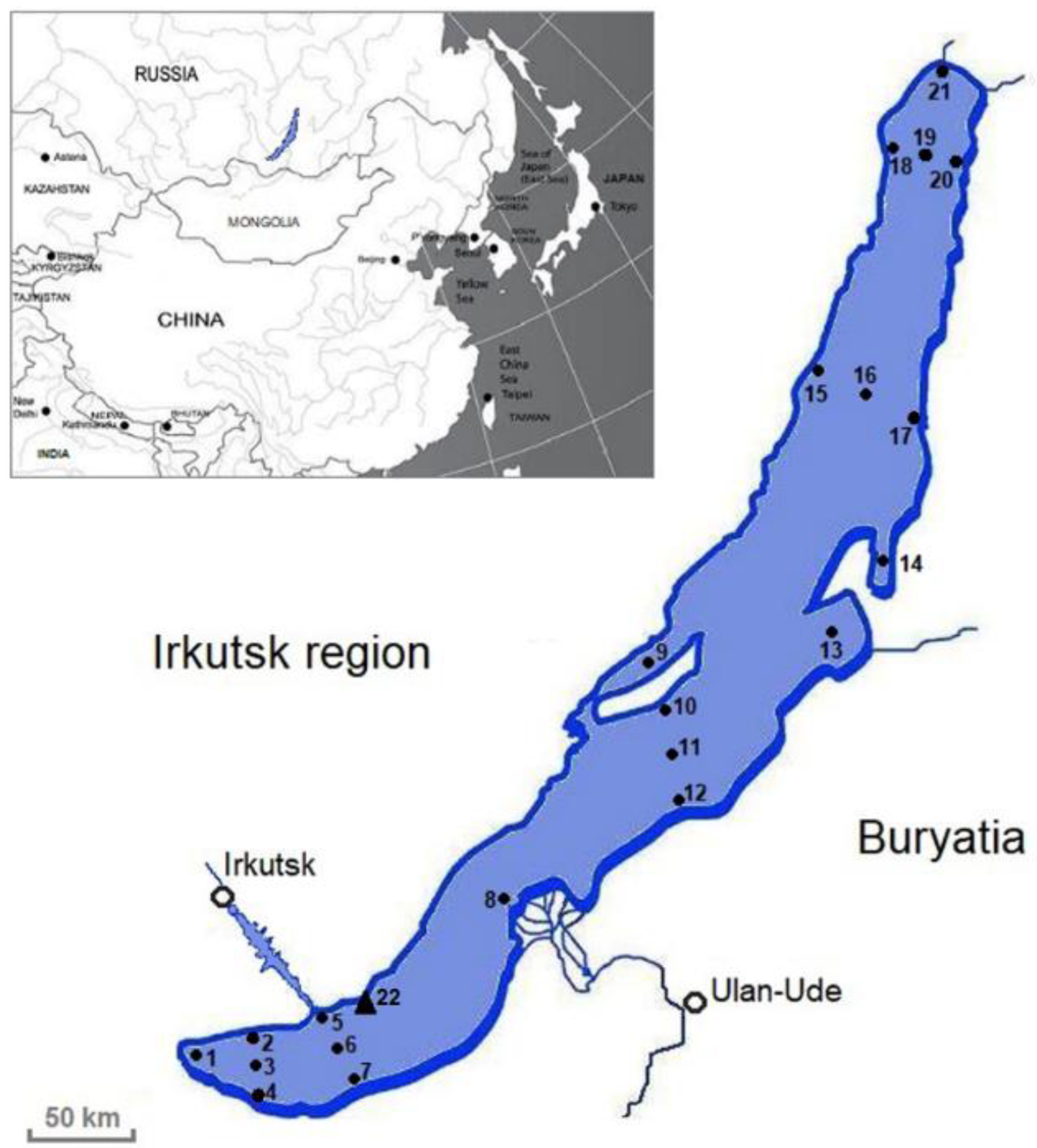
 and deep layers
and deep layers  of Lake Baikal determined during the monitoring of PCBs in Baikal water.
of Lake Baikal determined during the monitoring of PCBs in Baikal water.
 and deep layers
and deep layers  of Lake Baikal determined during the monitoring of PCBs in Baikal water.
of Lake Baikal determined during the monitoring of PCBs in Baikal water.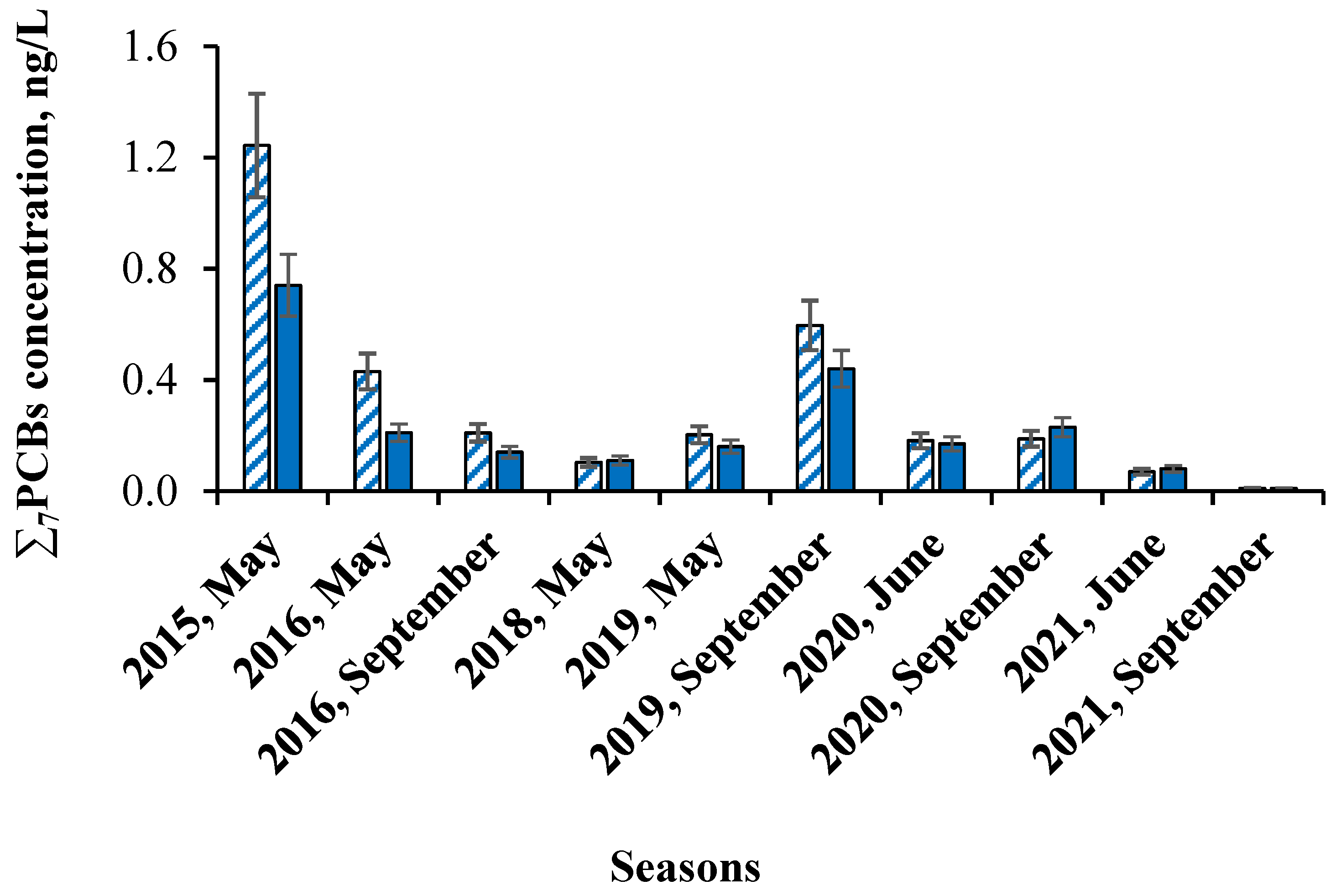
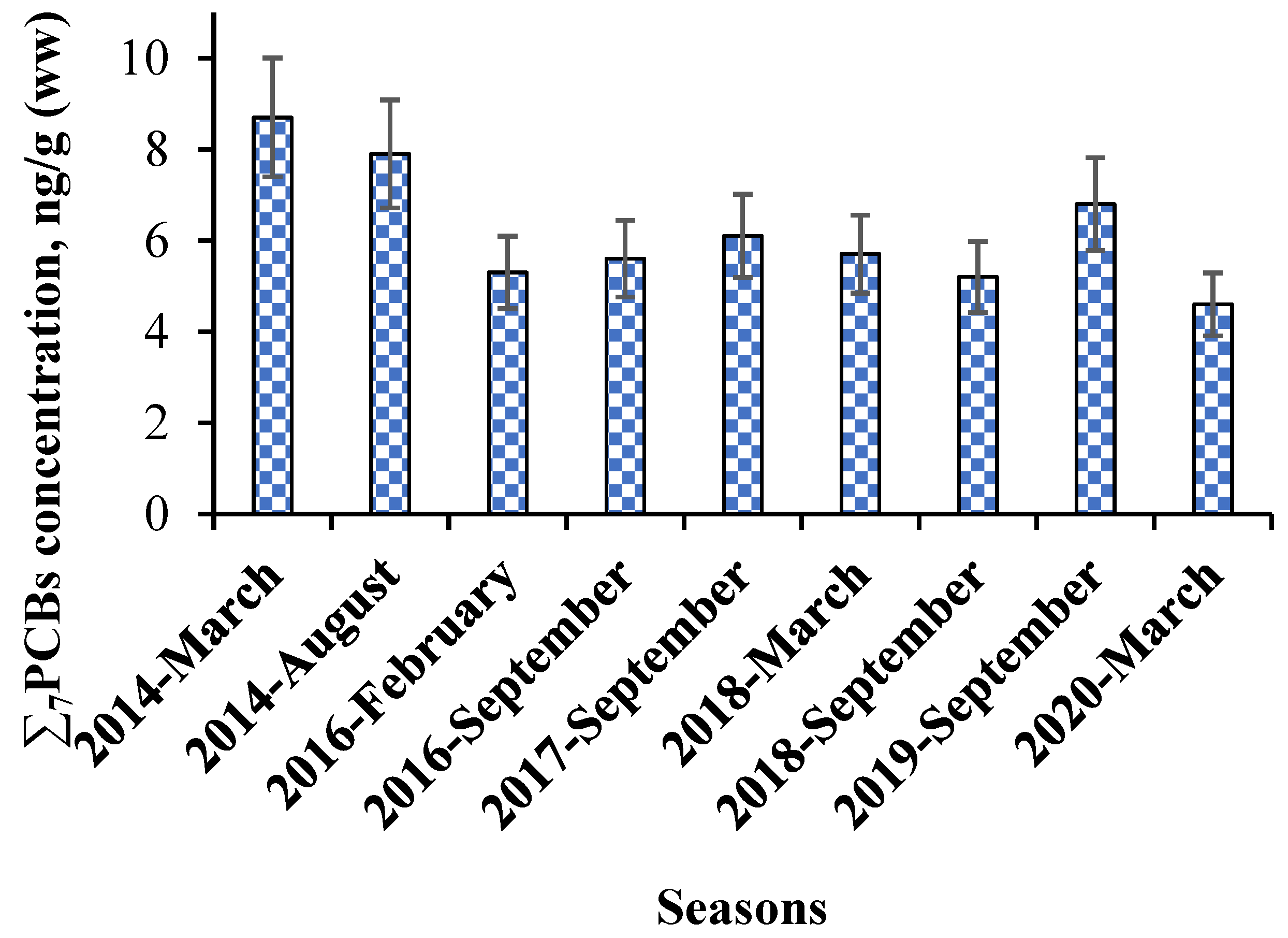
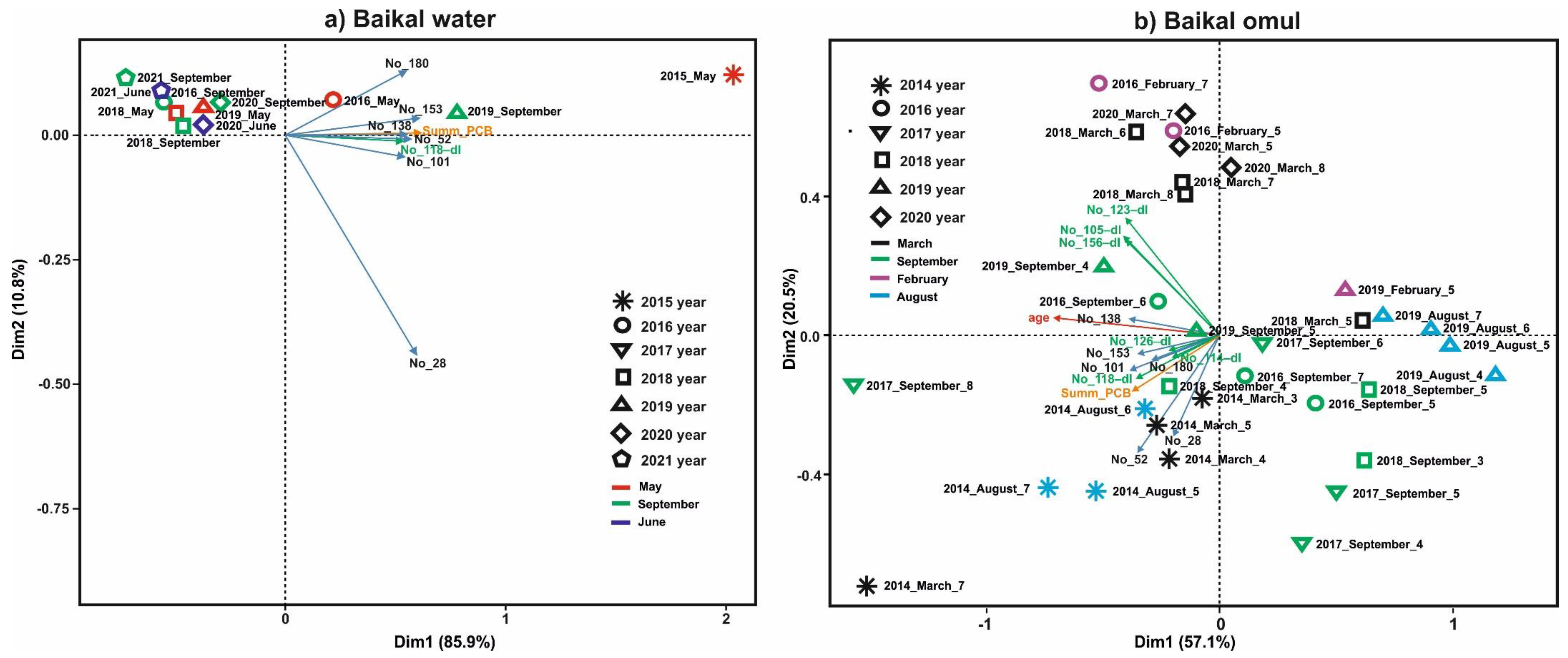
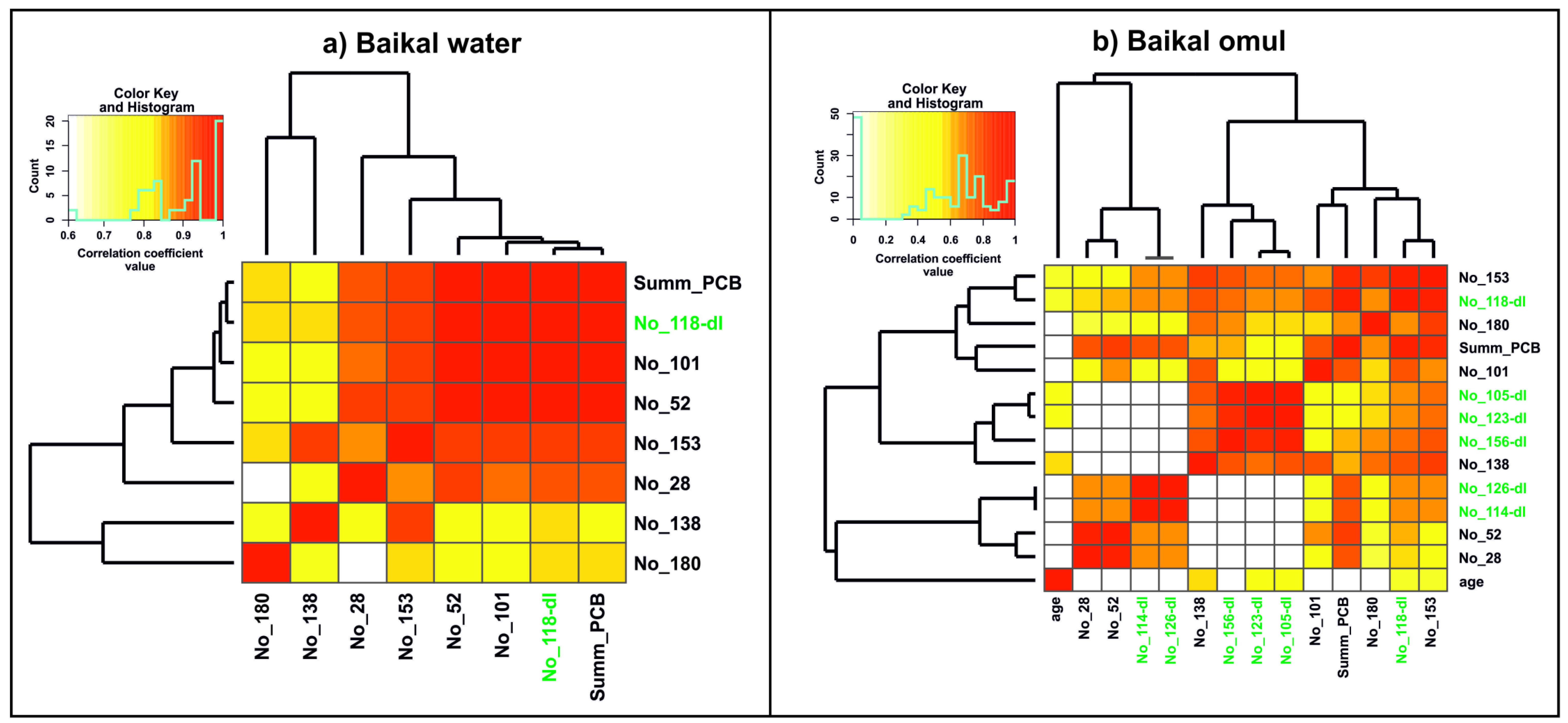
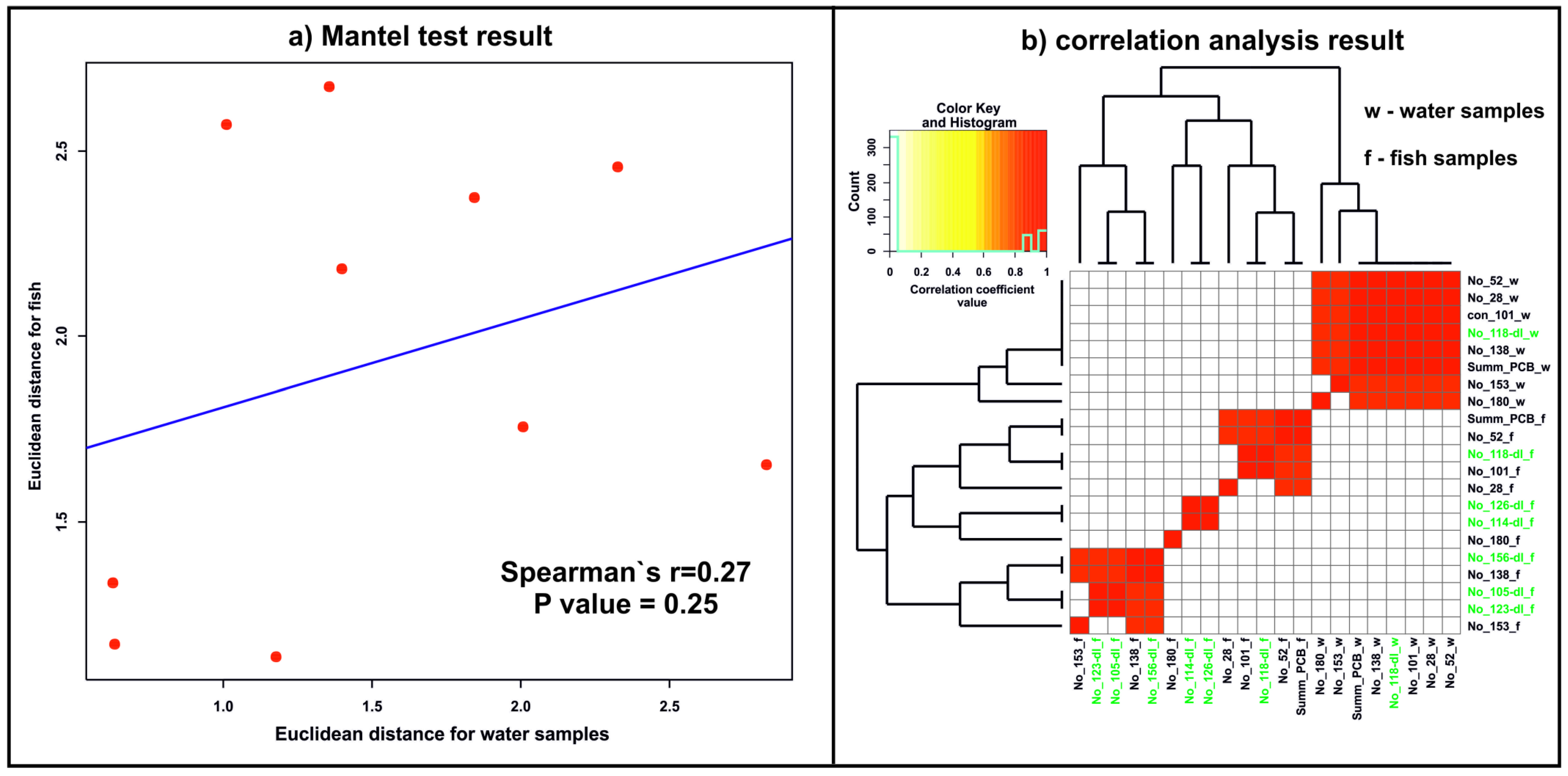
| Area | Year | PCBs in the Water, ng/L | References |
|---|---|---|---|
| Arctic | 2011 | ∑13PCBs 0.0013–0.021 | [9] |
| Arctic Norway | 1999 | ∑12PCBs 0.023–0.129 | [74] |
| Canadian Archipelago | 2018 | ∑PCBs 0.65–46 | [42] |
| Tropical Atlantic Ocean | 2021 | ∑PCBs 0.0041 ng/L | [12] |
| Antarctic, Victoria Land | 2011–2012 | ∑127PCBs 0.046–0.143 | [74] |
| European alpine lakes | 2000–2001 | ∑7PCBs 0.048–0.123 | [75] |
| Himalayas | 2007 | ∑5PCBs 0.02–0.45 | [76] |
| Lake Baikal, Russia | 2015–2021 | ∑24–34PCBs 1.4–9.7 ∑7PCBs 0.30; 0.26–0.34 | This study |
| Lake Como, Italy | 2007 | ∑7PCBs 0.30 | [77] |
| Caspian Sea, Russia | 2002 | ∑6PCBs: 0.10–7.3 | [78] |
| Lake Baiyangdian, China | 2008 | ∑39PCBs 19–132 | [79] |
| Area | Year | PCBs in the tissues of fish, ng/g ww | |
| Lake Baikal, Russia | 2014–2020 | C. migratorius, ∑7 PCBs 5.6; 4.9–6.3 | This study |
| Alpine lakes of Western Europe | 2003–2004 | Salmo trutta, ∑7 PCBs 6.3–13 | [30,31,32,33] |
| Southern Moravia, Czech Republic | 2013 | Carp, ∑7PCBs 2.4–14, Bream, ∑7PCBs 8.0–210 Pike perch, ∑7PCBs 2.4–4 | [27] |
| Baltic Sea, Polish fishing area | 2012 | Salmo salar, ∑6PCBs 7.7–61 Salmo trutta, ∑6PCBs: 31–56 Gadus morhua callarisa, ∑6PCBs: 0.07–2.8 | [80] |
| Legally binding documents, EU | 2019 | Food products, muscle meat of fish, ∑6PCBs 75 | [81] |
| Area | Year | PCBs in the tissues of fish, pg WHO-TEQ/g lw | |
| Lake Baikal, Russia | 2014–2020 | C. migratorius 0.03–0.06 | This study |
| Baltic Sea, Polish fishing area | 2003 | Salmo salar, 1.0–7.4 Salmo trutta, 4.2–9.0 Gadus morhua callarisa, 0.62–0.67 | [80] |
| Legally binding documents, EU | 2019 | Food products, muscle meat of fish, 3.0 | [81] |
Publisher’s Note: MDPI stays neutral with regard to jurisdictional claims in published maps and institutional affiliations. |
© 2022 by the authors. Licensee MDPI, Basel, Switzerland. This article is an open access article distributed under the terms and conditions of the Creative Commons Attribution (CC BY) license (https://creativecommons.org/licenses/by/4.0/).
Share and Cite
Gorshkov, A.G.; Kustova, O.V.; Bukin, Y.S. Assessment of PCBs in Surface Waters at Ultratrace Levels: Traditional Approaches and Biomonitoring (Lake Baikal, Russia). Appl. Sci. 2022, 12, 2145. https://doi.org/10.3390/app12042145
Gorshkov AG, Kustova OV, Bukin YS. Assessment of PCBs in Surface Waters at Ultratrace Levels: Traditional Approaches and Biomonitoring (Lake Baikal, Russia). Applied Sciences. 2022; 12(4):2145. https://doi.org/10.3390/app12042145
Chicago/Turabian StyleGorshkov, Alexander G., Olga V. Kustova, and Yurij S. Bukin. 2022. "Assessment of PCBs in Surface Waters at Ultratrace Levels: Traditional Approaches and Biomonitoring (Lake Baikal, Russia)" Applied Sciences 12, no. 4: 2145. https://doi.org/10.3390/app12042145
APA StyleGorshkov, A. G., Kustova, O. V., & Bukin, Y. S. (2022). Assessment of PCBs in Surface Waters at Ultratrace Levels: Traditional Approaches and Biomonitoring (Lake Baikal, Russia). Applied Sciences, 12(4), 2145. https://doi.org/10.3390/app12042145







